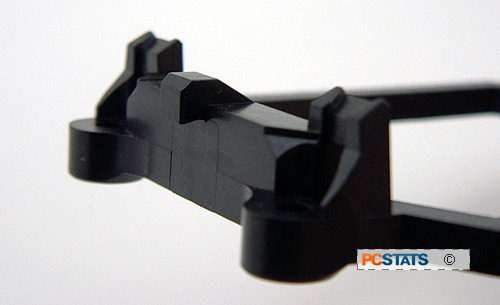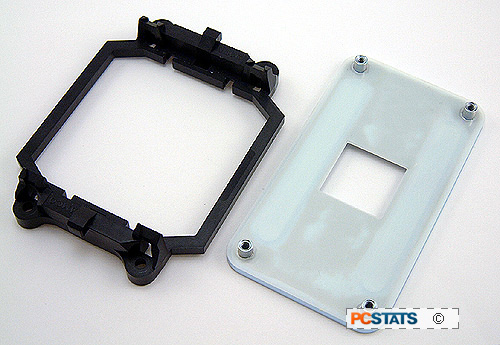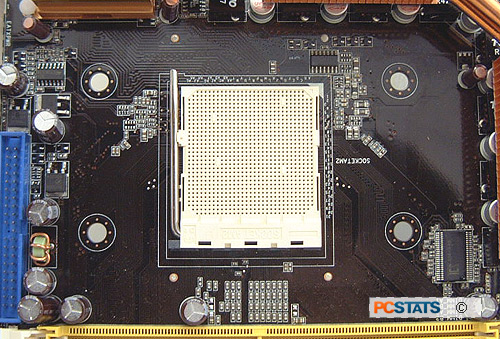 The 940-pin AMD socket AM2 Athlon64
processor to is physically speaking nearly identical to the previous generations of socket 754,
socket 939 and socket 940 AMD K8 processors. There is one very significant difference
as far as heatsinks are concerned however...
The 940-pin AMD socket AM2 Athlon64
processor to is physically speaking nearly identical to the previous generations of socket 754,
socket 939 and socket 940 AMD K8 processors. There is one very significant difference
as far as heatsinks are concerned however...
The socket AM2 processor uses newly designed plastic heatsink
retention frame that attaches to the ASUS M2N32-SLI Deluxe motherboard with
four screw holes, to a newly designed four-post metal PCB stiffener
backplate.
The new socket AM2
heatsink retention frame and metal backplate are not compatible with the
previous socket 754/939/940 heatsink retention frame and metal back plates, and
vice-versa.
AM2 motherboards like the ASUS M2N32-SLI Deluxe motherboard ship with the new AM2 heatsink retention frame, and
that means many existing Athlon64 K8 heatsinks are unuseable on the AM2
platform.

All existing K8 heatsinks that screw directly into the two-post
metal backplate of the socket 754/939/940 series are not usable with the socket
AM2 retention module, because its four-posts are positioned differently.
Unfortunately, most heatsinks that use this installation method are the
high-end, heavy copper coolers that offer the best performance qualities. The
weight of these expensive enthusiast level heatsinks dictated a firmer
attachment method than the plastic tabs of the old retention frame, and sadly
their useful life is now over.

AMD retail heatsinks that clip onto the socket
754/939/940 heatsink retention frame center tabs
will continue to be compatible
with the socket AM2 heatsink retention
frame. The center tabs survived the transition to socket AM2, alongside with
a new type of four-post socket 478-like integrated clip points. Existing K8 heatsinks
which use a cam-lock to apply pressure on the spring clip after
it has been attached to the retention frame tab will also work with AM2
motherboards like the ASUS M2N32-SLI Deluxe, though there are no lock tabs built onto
the retention cage itself.

Three tab K8 heatsink clips should
also work with AM2, but it depends on how well the load forces are
balanced. Uneven loading is usually associated with the very inexpensive thermal
solutions of lower quality standards. If you can avoid this type of
heatsink with socket AM2 processors, we'd recommend doing that.

The socket AM2 standard also introduces Pulse Width
Modulation (PWM) fan speed control, as identified by four-pin fan power cables. For the moment, both fan and motherboard
fan header remain backwards compatible with 3-pin RPM sensing fan power cables. The
ASUS M2N32-SLI Deluxe has its 4-pin PWM CPU fan header located just
behind the PS/2 jacks.
Next up, PCSTATS will walk you though some of the highlights
of the M2N32-SLI Deluxe motherboard that we've been looking at, and focus in
on a couple of its more unique aspects that are sure
to get enthusiasts excited!
